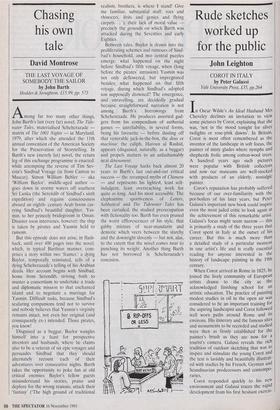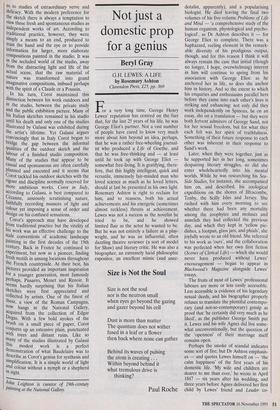Rude sketches worked up for the public
John Leighton
COROT IN ITALY by Peter Galassi
Yale University Press, £35, pp.264
In Oscar Wilde's An Ideal Husband Mrs Cheveley declines an invitation to view some pictures by Corot, explaining that she was, 'not in the mood tonight for silver twilights or rose-pink dawns'. In Britain, Corot is most often remembered as the inventor of the landscape in soft focus, the painter of misty glades where nymphs and shepherds frolic among cotton-wool trees. A hundred years ago such pictures were popular with British collectors and now our museums are well-stocked with products of an elderly, nostalgic painter. Corot's reputation has probably suffered because of our over-familiarity with the pot-boilers of his later years, but Peter Galassi's important new book could inspire even the most jaded critic to look again at the achievement of this remarkable artist. Galassi's focus might seem narrow — this is primarily a study of the three years that Corot spent in Italy at the outset of his career. But this is much more than a detailed study of a particular moment in one artist's life and is really essential reading for anyone interested in the history of landscape painting in the 19th century.
When Corot arrived in Rome in 1825, he joined the lively community of European artists drawn to the city as the acknowledged finishing school for an artistic education. The practice of painting modest studies in oil in the open air was considered to be an important training for the aspiring landscapist and Corot followed well worn paths around Rome and its environs. His itinerary and the famous sites and monuments to be recorded and studied were then as firmly established for the painter's brush as they are now for a tourist's camera. Galassi reveals the rich tradition of outdoor sketching that was to inspire and stimulate the young Corot and the text is lavishly and beautifully illustrat- ed with studies by his French, German and Scandinavian predecessors and contempo- raries.
Corot responded quickly to his new environment and Galassi traces the rapid development from his first hesitant exercis-
es to studies of extraordinary verve and delicacy. With the modern preference for the sketch there is always a temptation to view these fresh and spontaneous studies as independent works of art. According to traditional practice, however, they were Simply a means to an end, produced to train the hand and the eye or to provide Information for larger, more elaborate compositions painted in the studio. It was la the secluded world of the studio, away from the distracting light and life of the actual scene, that the raw material of nature was transformed into grand Imaginative compositions, imbued perhaps With the spirit of a Claude or a Poussin.
In his turn, Corot maintained this distinction between his work outdoors and In the studio, between the private study and the public exhibition picture. Many of his Italian sketches remained in his studio until his death and only one of the studies Illustrated by Galassi was exhibited during the artist's lifetime. Yet Galassi argues convincingly that in Italy Corot began to bridge the gap between the informal qualities of the outdoor sketch and the labour of a finished studio composition. Many of the studies that appear to be casual and spontaneous are often carefully Planned and executed and it seems that Corot tackled his outdoor sketches with the rigour and discipline normally reserved for more ambitious works. Corot in Italy, according to Galassi, is best compared to Cezanne, anxiously scrutinising nature, faithfully recording nuances of light and colour yet imposing a sense of order and design on his confused sensations.
Corot's approach may have developed from traditional practice but the vitality of his work was an effective challenge to the stale conventions of academic landscape Painting in the first decades of the 19th century. Back in France he continued to experiment, but now as a pioneer, finding fresh motifs in unsung locations throughout the French countryside. At their best, his Pictures provided an important inspiration for a younger generation, most famously Perhaps, Pissarro, Monet and Renoir. It seems hardly surprising that his Italian sketches were first appreciated and collected by artists. One of the finest of these, a view of the Roman Campagna, new hangs in the National Gallery, acquired from the collection of Edgar Degas. With a few bold strokes of the brush on a small piece of paper, Corot cc!ri.lures up an extensive plain, punctuated With trees and distant ruins. Like so Many of the studies illustrated by Galassi this modest work is a perfect demonstration of what Baudelaire was to describe as Corot's genius for synthesis and simplification. It is a simple world of light and colour without a nymph or a shepherd la sight.
John Leighton is curator of 19th-century Painting at the National Gallery.











































































 Previous page
Previous page